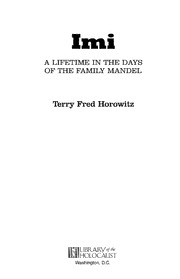
Imi: a lifetime in the days of the family Mandel PDF
Preview Imi: a lifetime in the days of the family Mandel
imi final 2:Layout 1 10/9/17 10:16 AM Page 1 H o r o w i t z I m i A L I F E T I M E I N T H E D A Y S O F T Imi H E F A M I L Y M A LIFETIME IN THE DAYS A N D E OF THE FAMILY MANDEL L Terry Fred Horowitz www.LibraryoftheHolocaust.org imi title 8/29/17 10:20 AM Page i Imi imi title:8/29/17 10:20 AM Page ii imi title: 8/29/17 10:20 AM Page iii Imi A LIFETIME IN THE DAYS OF THE FAMILY MANDEL Terry Fred Horowitz Washington, D.C. Copyright © 2017 by Terry Fred Horowitz All rights reserved. No part of this book may be reproduced or transmitted in any form or by any means, electronic or mechanical without written permission from the publisher, except for the inclusion of brief quotations in a review. Printed in the United States of America ISBN: 978-1882326-13-6 (print edition) Library of Congress Control Number: 2017954609 Library of the Holocaust Foundation PO Box 1651 Silver Spring, Maryland 20915 (800)651-9350 www.LibraryoftheHolocaust.org Contents Preface / vii Chapter One / 1 Chapter Two / 9 Chapter Three / 21 Chapter Four / 39 Chapter Five /59 Chapter Six / 73 Chapter Seven / 85 Chapter Eight / 95 Chapter Nine / 103 Chapter Ten / 109 Chapter Eleven /123 Epilogue / 127 Selected Bibliography /153 Preface In 1993, four years after the Communist state in Hungary was dismantled and two years after the last Soviet troops were withdrawn from that country, effectively ending the War- saw Pact, my wife, Judy, and I, and another couple with their daughter, visited Czechoslovakia, Hungary and Poland. Over a period of two weeks we made a pilgrimage to five former concentration camps—Theresienstadt, Treblinka, Auschwitz, Birkenau (Auschwitz II), and Majdanek. We knew that at Auschwitz-Birkenau, on the outskirts of Oswiecim, and Southwest of Cracow, Poland, we would be visit- ing the largest killing center in the entire Nazi universe. Of the approximately 2,000,000 Jews killed there, in the summer of 1944, 437,402 of them had been deported from Hungary. While there, we saw the railroad track leading to gate with the mocking sign, Arbeit Mach Frei (work makes you free), the elevated watch towers, the few remaining barracks, the blown-up remnants of the cre- matoria, the rooms used for “experimentation,” plus stacks of shoes, glasses, and luggage. At one point, while we were saying a vii viii IMI silent prayer, a nearby group of Polish teenagers romped about, yelling at one another, oblivious to the historical nature of our environs. At Treblinka, about fifty miles northeast of Warsaw, we saw concrete blocks, symbolically marking the path of the for- mer railway line, and the seventeen thousand stones, each one representing a Jewish town or city, the population of which was exterminated at the camp. At Theresienstadt, forty miles Northwest of Prague, in the Czech Republic, we explored the quintessential propaganda camp, which hid a more sinister purpose. In reality, this “beau- tified” ghetto had been a collection center for deportations for forced labor, or more likely, to extermination camps. Of the 140,000 Jews transferred to Theresienstadt, 90,000 were “de- ported,” to their deaths, while of the remaining 50,000, 33,000 died there. But, it was Majdanek, overlooking the Polish town of Lu- blin, that had the most lasting and devastating impact on me. It was still in “pristine” condition—barbed wire (electrical fence), guard towers, crematorium, gas chamber, dissection table, and shoes of camp victims. One estimate (Russian) surmised that no less than 400,000 Jews had been put to their death there. While walking toward an open field in which thousands of these vic- tims had been burned, covered with lime, and then buried in mass graves, I stumbled upon a large white object, which, ac- cording to my doctor companion, was part of a human pelvis! It had been there for over fifty years. In Martin Gilbert’s book, Atlas of the Holocaust, his estimates are listed by region and country. By my count, 5,352, 349 Jews were murdered between 1 September 1939 and 8 May 1945. My father’s parents came from Brest-Litovsk, my mother’s from Minsk, in present-day Belarus. Both cities were in the so- called “Pale of Settlement,” which, throughout history, had gone
